The Economics and Statistics Division maintains archives of previous publications for accountability purposes, but makes no updates to keep these documents current with the latest data revisions from Statistics Canada. As a result, information in older documents may not be accurate. Please exercise caution when referring to older documents. For the latest information and historical data, please contact the individual listed to the right.
<--- Return to Archive
For additional information relating to this article, please contact:
February 09, 2021JAPAN CURRENT ACCOUNT AND TRADE BALANCE, DECEMBER AND ANNUAL 2020 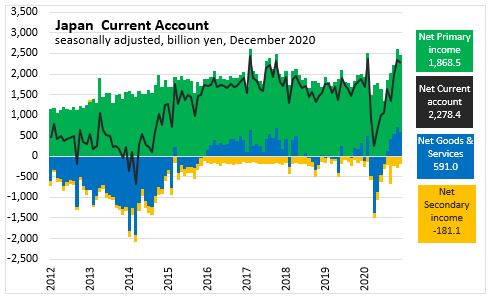
Current Account (December 2020 vs November 2020)
The current account surplus narrowed by 61 billion yen to 2,278 billion yen.
The goods and services trade surplus narrowed by 130 billion yen to 591 billion yen.
The primary income surplus narrowed by 30 billion yen to 1,869 billion yen.
The secondary income deficit narrowed by 99 billion yen to 181 billion yen.
Trade Balance (December 2020 vs November 2020)
Japan's goods trade surplus narrowed by 129 billion yen to 868 billion yen.
Exports of goods decreased 125 billion yen to 6,101 billion yen.
Imports of goods increased 4 billion yen to 5,233 billion yen.
As a result, Japan's goods trade surplus narrowed by 129 billion yen to 868 billion yen.
Net Services trade deficit widened by 1 billion yen to 277 billion yen.
As a result, goods and services trade surplus narrowed by 130 billion yen to 591 billion yen.
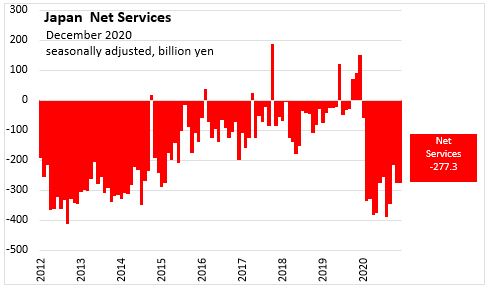
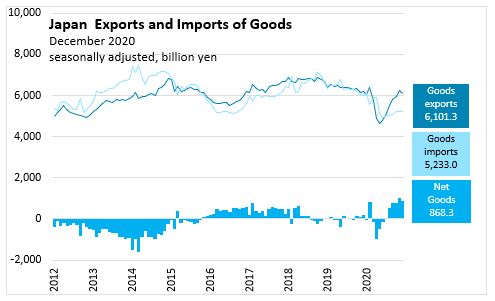
CURRENT ACCOUNT AS A SHARE OF GDP
The ratio of the current account balance to the Gross Domestic Product (or % of GDP) provides an indication of the country's trade and income flows relative to the size of the economy.
The ratio is calculated by dividing the net values of exports less imports, primary Income (interest and dividends) and secondary income (transfers) over a period by the gross domestic product for the same period. Although called a ratio, it is usually expressed as a percentage.
A current account surplus indicates upward pressure on the foreign exchange rate unless it is offset by net outflows (leading, acquisition of assets) outside the country.
Japan's current account surplus (as measured as a share of GDP) increased from 2020Q2 to 2020Q3, increasing by 1.4 percentage points to 3.0%.
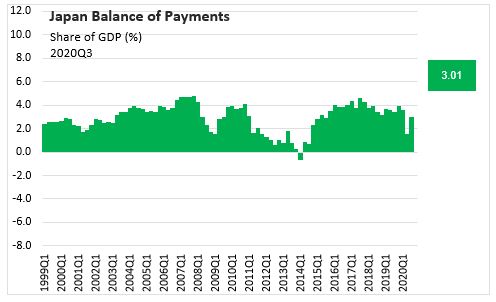
Annual Current Account (2020 vs 2019)
In 2020, Japan's net goods and services trade surplus widened by 400.8 billion yen to 506 billion yen.
Net primary income surplus widened by 97 billion yen to 21,395 billion yen.
Net secondary income deficit narrowed by 628 billion yen to 1,376 billion yen.
As a result, Japan's current account surplus widened by 1,126 billion yen to 20,526 billion yen.
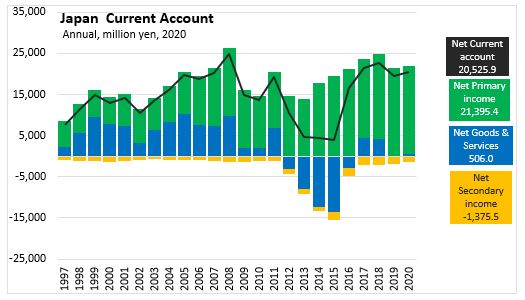
Annual Trade Balance (2020 vs 2019)
In 2020, Japan's exports of goods decreased 5,195 billion yen to 76,031 billion yen.
Japan's imports of goods decreased 4,450 billion yen to 75,650 billion yen.
As a result, Japan's net services trade surplus changed from a deficit (1,021 billion yen) to a surplus (125 billion yen) over 2019.
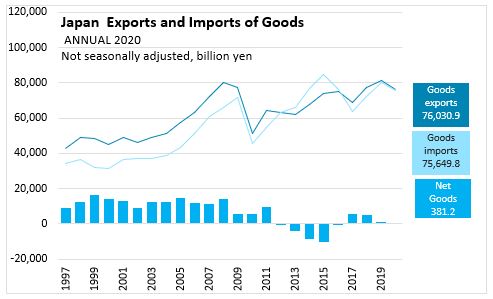
REFERENCES
Report | Press Release | Balance of Payments
Based on Table 6s-a-2 Current Account (seasonally adjusted), Monthly
OECD, Quarterly balance of payments statistics
<--- Return to Archive